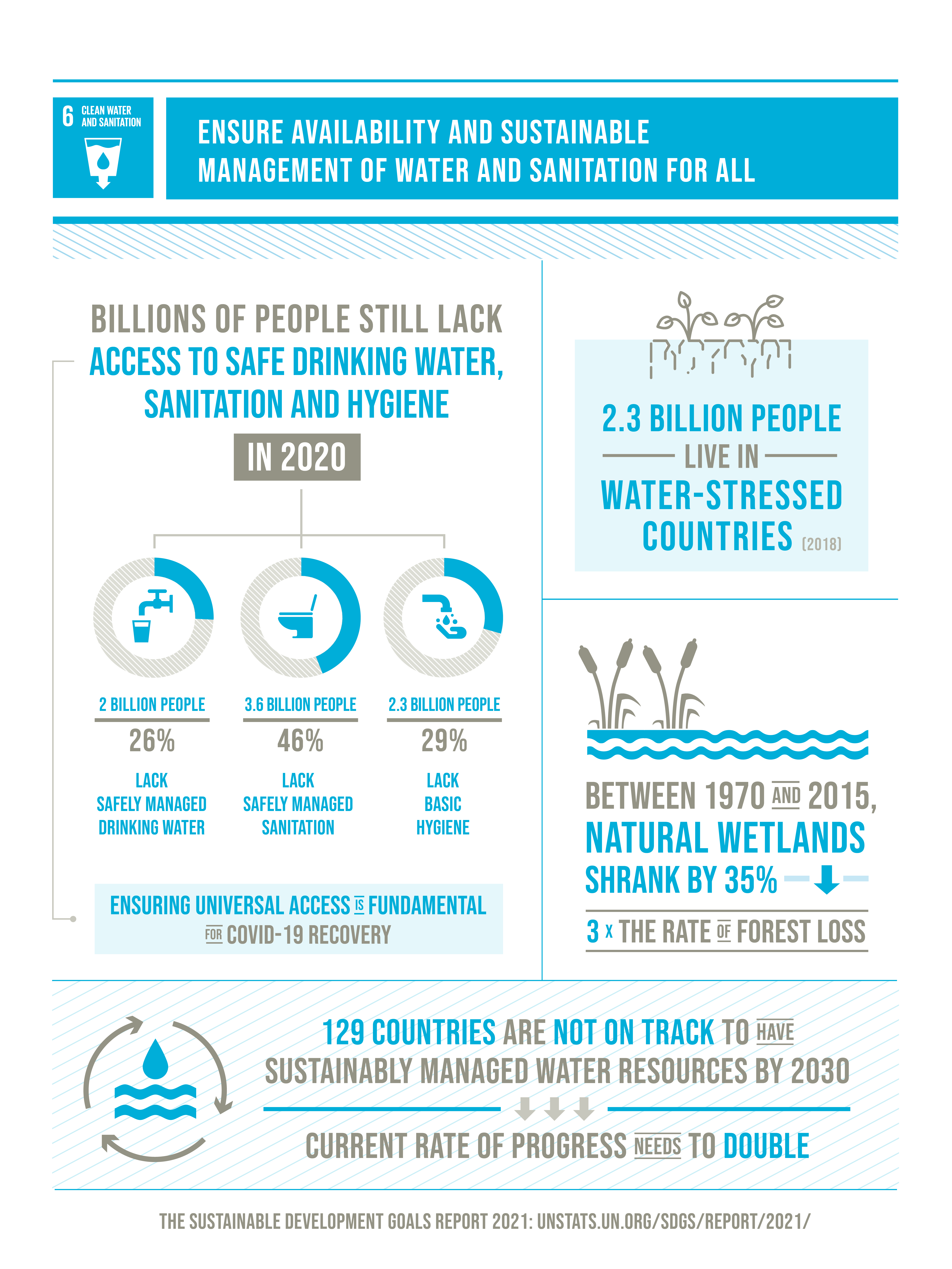



Worldwide, one in three people do not have access to safe drinking water, two out of five people do not have a basic hand-washing facility with soap and water, and more than 673 million people still practice open defecation.
The COVID-19 pandemic has demonstrated the critical importance of sanitation, hygiene and adequate access to clean water for preventing and containing diseases. Hand hygiene saves lives. According to the World Health Organization, handwashing is one of the most effective actions you can take to reduce the spread of pathogens and prevent infections, including the COVID-19 virus. Yet billions of people still lack safe water sanitation, and funding is inadequate.
Facts and Figures:-
- 1 in 4 health care facilities lacks basic water services
- 3 in 10 people lack access to safely managed drinking water services and 6 in 10 people lack access to safely managed sanitation facilities.
- At least 892 million people continue to practice open defecation.
- Women and girls are responsible for water collection in 80 per cent of households without access to water on premises.
- Between 1990 and 2015, the proportion of the global population using an improved drinking water source has increased from 76 per cent to 90 per cent
- Water scarcity affects more than 40 per cent of the global population and is projected to rise. Over 1.7 billion people are currently living in river basins where water use exceeds recharge.
- 2.4 billion people lack access to basic sanitation services, such as toilets or latrines
- More than 80 per cent of wastewater resulting from human activities is discharged into rivers or sea without any pollution removal
- Each day, nearly 1,000 children die due to preventable water and sanitation-related diarrheal diseases
- Approximately 70 per cent of all water abstracted from rivers, lakes and aquifers is used for irrigation
- Floods and other water-related disasters account for 70 per cent of all deaths related to natural disasters
6.1 By 2030, achieve universal and equitable access to safe and affordable drinking water for all
6.2 By 2030, achieve access to adequate and equitable sanitation and hygiene for all and end open defecation, paying special attention to the needs of women and girls and those in vulnerable situations
6.3 By 2030, improve water quality by reducing pollution, eliminating dumping and minimizing release of hazardous chemicals and materials, halving the proportion of untreated wastewater and substantially increasing recycling and safe reuse globally
6.4 By 2030, substantially increase water-use efficiency across all sectors and ensure sustainable withdrawals and supply of freshwater to address water scarcity and substantially reduce the number of people suffering from water scarcity
6.5 By 2030, implement integrated water resources management at all levels, including through transboundary cooperation as appropriate
6.6 By 2020, protect and restore water-related ecosystems, including mountains, forests, wetlands, rivers, aquifers and lakes
6.A By 2030, expand international cooperation and capacity-building support to developing countries in water- and sanitation-related activities and programmes, including water harvesting, desalination, water efficiency, wastewater treatment, recycling and reuse technologies
6.B Support and strengthen the participation of local communities in improving water and sanitation management
Billions of people worldwide still live without safely managed drinking-water, sanitation and hygiene services, which are critical for protecting human health and containing the spread of the COVID-19 virus. Over the past century, global water use has increased at more than twice the rate of population growth. In addition to water stress, countries and territories are facing growing challenges linked to water pollution, degraded water-related ecosystems, water scarcity caused by climate change, and a lack of cooperation on transboundary waters. The world is not on track to achieve Goal 6. A dramatic acceleration is needed in the current rates of progress and in integrated and holistic approaches to water management.
Between 2000 and 2020, the global population using safely managed drinkingwater and sanitation services increased by 2 billion and 2.4 billion, respectively. Despite the progress, 2 billion people lacked safely managed drinking-water services, 3.6 billion safely managed sanitation services and 2.3 billion basic hygiene services in 2020. One in three people worldwide still lack basic handwashing facilities with soap and water at home, leaving them especially vulnerable to the COVID-19 virus.
Among the 42 countries and territories reporting on total wastewater generation and treatment in 2015, 32 per cent of wastewater flows were subject to some form of treatment. An estimated 56 per cent of wastewater generated by households in 2020 was safely treated, according to data from 128 countries and territories.
An assessment of rivers, lakes and aquifers of 89 countries and territories in 2020 indicates that the water quality of 72 per cent of the water bodies assessed is good. Protection is easier than restoration, so efforts to protect these water bodies from pollution must be initiated now.
Improving water use efficiency is a key measure that can contribute to reducing water stress in a country. Global efficiency increased from $17.30 per m3 in 2015 to $19 per m3 in 2018, a 10 per cent increase. All economic sectors have experienced an increase in water use efficiency since 2015, with increases of 15 per cent in the industrial sector, 8 per cent in the agricultural sector and 8 per cent in the services sector.
In 2018, global water stress was estimated to be 18.4 per cent, an increase from 18.2 per cent in 2015. Regions such as Western and Southern Asia and Northern Africa present very high levels of water stress at more than 70 per cent, while SouthEastern Asia, Latin America and the Caribbean, and sub-Saharan Africa saw their water stress levels increase from 2017 to 2018.
In 2020, 129 countries and territories were not on track to meet the target for implementing integrated water resources management by 2030, which includes financing and intersectoral coordination mechanisms, basin management and monitoring. The rate of implementation needs to double globally. In many countries and territories, the COVID-19 pandemic has led to wider stakeholder engagement in water resources management through online consultations.
Advancing transboundary water cooperation plays a crucial role in preventing conflicts and supporting wider regional integration, peace and sustainable development. However, according to data from 2017 and 2020, only 24 of the 153 countries and territories that share transboundary rivers, lakes and aquifers have 100 per cent of their transboundary basin area covered by operational arrangements, and only another 22 countries and territories have more than 70 per cent covered.
Freshwater ecosystems and the multitude of resources that they provide are changing dramatically. One fifth of the world’s river basins are experiencing rapid increases or decreases in surface water area. This unprecedented situation is compounded by pollution in large lakes and the persistent loss and degradation of wetlands and freshwater biodiversity. Between 1970 and 2015, the total area of inland and marine or coastal wetlands declined by approximately 35 per cent, three times the rate of forest loss. Existing efforts to protect and restore water-related ecosystems must be scaled up and accelerated urgently.
From 2015 to 2019, ODA disbursements to the water sector remained stable at around $8.8 billion, while ODA commitments to the water sector rose by 9 per cent. In the same period, concessional lending for the least developed countries increased by 52 per cent to $2 billion, with ODA grants to those countries increasing by only 8 per cent.
In 2018 and 2019, two thirds of the 109 reporting countries and territories had procedures for the participation of local communities in water and sanitation management that were defined in laws or policies. However, only 14 countries and territories reported high levels of community and user participation in collaborative management and decision-making.
In 2017, an estimated 3 billion people worldwide lacked the ability to safely wash their hands at home – one of the cheapest, easiest and most effective ways to prevent the spread of diseases like the coronavirus. Water, sanitation and hygiene services are also not always available at medical care facilities: in 2016, one in four facilities around the world lacked basic water supplies, one in five had no sanitation services, and two in five had no soap and water or alcohol-based hand rub, at points of care. And today, 4.2 billion people are still faced with daily challenges accessing even the most basic of services. Of these, 673 million people practised open defecation. By managing our water sustainably, we are also able to better manage our production of food and energy and contribute to decent work and economic growth. Moreover, we can preserve our water ecosystems, their biodiversity, and take action on climate change.
Civil society organizations should work to keep governments accountable, invest in water research and development, and promote the inclusion of women, youth and indigenous communities in water resources governance. Generating awareness of these roles and turning them into action will lead to win-win results and increased sustainability and integrity for both human and ecological systems. You can also get involved in the World Water Day and World Toilet Day campaigns that aim to provide information and inspiration to take action on hygiene issues.
[Source:- www.un.org]